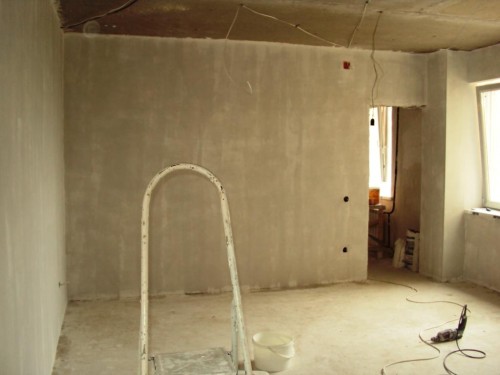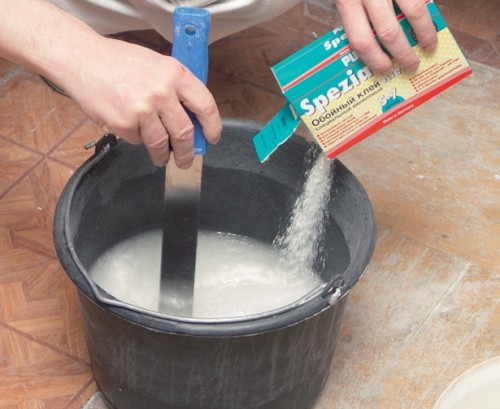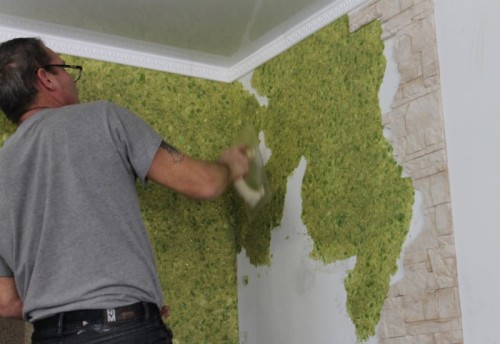Repair in the kitchen is troublesome and at the same time pleasant. So that after the work, it becomes a favorite place for the collection of the whole family, it is worth treating the walls with all responsibility, since the specifics of the kitchen work involves the regime of high temperatures and humidity. Thus, if you are going to glue the walls of the kitchen with wallpaper, the finishing material of the appropriate quality will be required. Having embodied the idea, you can achieve excellent results of decorating the room. In such a disposal, it will be pleasant to cook, as well as gather at the kitchen table to drink a cup of tea or coffee and chat.
Content
How to choose a kitchen wallpaper
With the help of a well -chosen chosen finishing material, it is easy to give the design of the interior of the kitchen premises the uniqueness and originality. The competent design of the kitchen with wallpaper will help to hide the small irregularities of the walls of the walls, bring a note of comfort and comfort to the kitchen interior. Thanks to the rich choice presented on sale, it is easy to choose this finishing material in such a way that the most successful and low costs use wallpaper for the kitchen in the interior of a particular room.
Useful tips
When selecting wallpaper for the kitchen, you should proceed from their practicality. If you are actively preparing in the kitchen, you hardly expect that the wallpaper will remain perfectly clean, since kitchen evaporation, butter, fat and soot can leave their traces on them. If you finish the kitchen with not too suitable materials, then soon they will have to be changed, after a new repair. Therefore, it is worth selecting dense, resistant to mechanical influences, not exposed to burnout, vapor permeable and moisture -resistant wallpapers (withstanding wiping with a moisturized sponge or a fabric cloth). It is also desirable that they are washing (repeated washing is allowed for such wallpaper, including using household chemicals). Superfanting wallpapers are also presented on sale - such a kitchen covering of walls withstands even cleaning with a brush.
Next, you will need to determine the design of the wallpaper - to choose them so that they harmoniously look in the interior of a particular kitchen room. Designers do not advise using a dark color in the interior of a small kitchen and with a large pattern, since such wall colors can additionally optically reduce the room. To increase the room, it is worth picking up the canvases of light shades with a discreet pattern. If the kitchen goes north, wallpaper in warm colors is suitable. If desired, the kitchen walls are easy to finish with wallpaper, which can be repeatedly repainted in various colors. The combination of wallpaper in the kitchen looks quite original, with its help it is easy to zone the space, highlighting in the room a comfortable working and cozy dining area.
Before buying finishing material, it is recommended to supervise the batch number - it is desirable that it be the same for the same type rolls, since products from different parties may noticeably differ in shades.
Varieties of wallpaper for kitchen
On sale are the following varieties of wallpaper for the kitchen:
- paper - are the cheapest and short -lived. As the advantages of such a finishing material, it is worth mentioning environmental friendliness and high breathability. Paper wallpapers with a impregnation or a minimum layer of vinyl are suitable for a kitchen room with a minimum load, otherwise, under the influence of steam and kitchen pollution, such a finish will quickly become unusable. Before gluing such wallpaper, it will be necessary to qualitatively align the walls, since thin paper canvases can emphasize the existing surface defects;
- vinyl - these wallpaper are a polymer coating for walls applied to the base of technical paper or non -woven. Vinyl wallpapers provide ample opportunities for decorating the kitchen room, while they are wear -resistant and durable, are not exposed to burnout, they are not absorbed by moisture, it is easy to wash them from any pollution and spots using various products of household chemicals, sponge or brushes. Wallpaper coating from vinyl on a non -woven non -woven basis does not give shrinkage on the walls, since the non -woven is characterized by significant elasticity. Having bought vinyl wallpapers with micropores, you will get a detergent and “breathing” wall coating that is characterized by increased air permeability and at the same time does not absorb moisture - thus, condensate will not accumulate on the walls under these wallpaper and a fungus or mold will not appear. If you are going to glue cheaper, not “breathing” wallpaper, the wall will first need to be treated with special antifungal impregnation;
- the glass wallpaper for painting will give the wall the desired texture and relief, they can be painted in any colors you like. Such wallpapers look stylish and spectacular, while vapor permeable, differ in moisture and fire resistance, strength and durability. As the disadvantages of such wall decoration in the kitchen, wallpaper can be mentioned that it is almost impossible to peel off this coating from the wall;
- wnerle wallpaper is made of acrylic and polyester with the addition of natural compressed cellulose or viscose fibers. Such canvases are easily glued and help to hide some surface defects. The non -woven wallpapers for the kitchen are moisture resistance and fire resistance, high elasticity and are almost not subject to deformation, provide reliable sound insulation. If you are tired of the color of the walls in the kitchen, it will be easy to update, since non-woven wallpaper for painting for the kitchen is kept up to 7-10 staining cycles;
- liquid wallpaper - appeared on the market of finishing materials relatively recently, and are a textile coating consisting of various threads and fibers (cotton, cellulose, viscose, acetate silk, etc.), as well as adhesive. The finishing of the kitchen with liquid wallpaper allows you to create various patterns on the walls - such a coating is applied to the walls like plaster. Using this finishing material, it is easy to process the walls with a complex relief, hide any cracks and smooth out the irregularities of the walls without leaving the seams. Liquid wallpapers are characterized by high heat and soundproofing properties, do not attract dust, it is easy to wash, moreover, if necessary, a fragment of such a finish is easy to replace. The advantages of the use of liquid wallpaper for the kitchen include their wear resistance, a wide selection of colors, and at the same time a completely democratic price;
- bamboo wallpaper - made from dried bamboo strips, which are attached to the fabric base using special glue or seams from natural or nylon threads. Such wallpapers do not paint in order to maintain a natural type of bamboo surface. Among the advantages of using bamboo wallpaper in the kitchen, it is worth noting their resistance to temperature extremes and a high humidity regime, the ability to absorb noise, strength and durability. Bamboo wall coating does not burn out in the sun. Such wallpapers are antistatic and do not accumulate dust, which is especially important for people with a tendency to allergies.

How to paste the walls of the kitchen with wallpaper
It is not too difficult to figure out the intricacies of the process on the intricacies of the process and learn how to glue wallpaper in the kitchen. Decorating the walls of the kitchen room in this way is quite real with your own hands. It is convenient to do this together, having enlisted the support of the assistant.
For pasting the kitchen, wallpaper may need the following tools and materials:
- spatula;
- scissors;
- chancellery knife;
- roller;
- painting brush;
- construction level or plumb line;
- simple pencil or marker;
- primer fluid;
- wallpaper glue;
- pure rag;
- wallpaper.
Preliminary preparation
In order for the wallpaper to be held on the walls as firmly as possible, it will be necessary to pre -prepare the surface of the base. To do this, you need to get rid of the old finish, including the remains of the wallpaper - if they are firmly glued, it is recommended to moisturize them with a roller or a brush and, after softening, remove them with a metal spatula. It will also be necessary to clean with the surface with a peeling paint and plaster and stroke the walls, as well as to close small potholes and cracks using a starting putty, deep-cement-sand mortar. Then you need to wipe the walls from dust with a wet tissue cloth and wait for them to dry. After that, a deep penetration fluid is applied to the walls - this measure will prepare the base for pasting with wallpaper and will further avoid the appearance of fungi and mold under them. After that, it may be necessary to align by treating the surface of the kitchen walls with a layer of putty 1-2 cm thick-while the wall plane should be checked using a construction rule or a long wooden rail. The final surface for pasting the wallpaper should be dense and solid. It is most likely not necessary to align it to a perfectly smooth state, since most types of wallpaper for the kitchen will quite effectively hide small defects and wall errors.
After the walls dried, using a plumb line, a vertical line on the wall, on which you need to focus when gluing the first panel of the wallpaper on the surface. Air -permeable wallpaper can only be glued to completely dry walls. To check that they are completely dried up, you can glue a small piece of polyethylene on them at night. If condensate gathered under it, it means that you still need to wait until the final drying of the walls.
Next, you will need to prepare a suitable glue for wallpaper. It should be borne in mind that for each of their types, a certain adhesive composition may be required - the quality of wallpaper gluing and their further operation will largely depend on its correct selection. It is important to note that glue for ordinary paper wallpaper is not suitable, for example, for glass wallpaper, since such a textured wall covering is large and for its high -quality adhesion to the wall, it is necessary to apply another adhesive composition. For bamboo wallpaper, the “liquid nails” or a special vinyl adhesive composition is suitable, to fix them on the surface of drywall, chipboard or fiberboard, you can use a stapler, as well as decorative nails for wallpaper. Typically, manufacturers offer a specially balanced wallpaper glue for a certain type of finishing material. Read the instructions carefully and follow its instructions in the process of preparing the adhesive mixture.
Wallpaper wallpaper wallpaper
Many masters begin to glue the wallpaper from the corner, v and with a small clearance that compensates for the coincidence of the pattern on the canvases. Some professionals also recommend gluing wallpaper, starting with the wall most remote from the window opening, gradually moving towards it. At the same time, you will need to avoid drafts, as well as direct sunlight on the walls, close all windows, turn off the fans and air conditioners. If you have chosen glass wallpaper, you will need to protect yourself from getting glass of glass on the body - for this you need to put on clothes with long sleeves, as well as protective gloves.
You can measure the wallpaper directly on the wall or on the table, the floor, not forgetting to leave a small allowance (about 10 cm). If you need to choose a pattern in height, then the wallpaper is cut into account taking into account the rapport of the pattern (the step of the repeating image). The number of lanes must be calculated taking into account joints, protrusions, niches, as well as, if necessary, the selection of the picture. The cut canvases are folded in piles with a slight displacement.

Further, to glue the walls of the kitchen, the wallpaper will need to be performed by the following actions:
- application of glue - the quality of gluing wallpaper will largely depend on this stage. First, glue is applied to the wall under the first panel. Read the information indicated on the packaging of the wallpaper used. Sometimes only the walls are coated with adhesive mixture, in other cases it is necessary to treat their surface with glue, as well as the canvas of the wallpaper;

- climbing into the stepladder, prepared stripes are laid on the walls and rolled with a roller or a spatula from top to bottom and obliquely with smooth movements to remove air bubbles from under them;
- the edge of the panel at the ceiling must first be slightly wrapped so that the glue does not stain the wall. After that, you should press the wallpaper to the wall and smooth them with a brush. If the baseboard was not pre -dismantled, the wallpaper is laid in the joints between the baseboard and the floor;
- the adhesive of the glue that performed along the edges of the wallpaper must be carefully removed with a clean dry rag or sponge;
- in places with a complex relief (for example, in niches), you need to make cuts on the wallpaper to bend them from above and below. The canvas is wrapped in the right places and tightly pressed for reliable gluing, the excess material is carefully cut;
- having glued the canvas, you need to cut the hanging edges of the finishing material using a sharp knife or scissors. At the same time, it is necessary to try so that the cut is as smooth and smooth as possible.

Partly attention will require special attention when gluing the kitchen. Behind the heating radiators, it is recommended to start the wallpaper canvas no more than 20 cm below the top of the batteries. To press the wallpaper to the wall in hard -to -reach places, it is convenient to use a narrow roller with a long handle. The switches and sockets before gluing the walls are pre -dismantled, the wallpaper canvases are glued on top - and having waited for the glue to dry, the desired holes are carefully cut out with scissors. After the end of the work, the outlet and the switches must be screwed into place.
Applying liquid wallpaper to kitchen walls
Liquid wallpaper is perfect for the conditions of the kitchen room - such a seamless, strong surface will look harmonious and original in it. The technology of wall decoration with liquid wallpaper is simple. First, according to the instructions, dilute the dry mixture according to the instructions, mix thoroughly and leave for swelling for several minutes. Further, the prepared mass using a wide spatula must be applied and distributed on the surface of the walls. In case of damage to the site of such a coating, you will need to apply a small amount of this mixture on it.





















